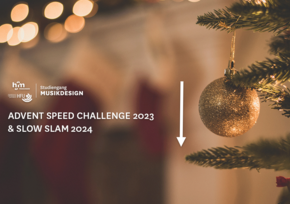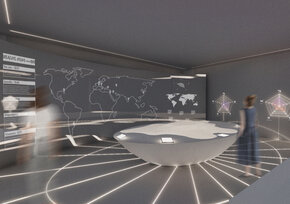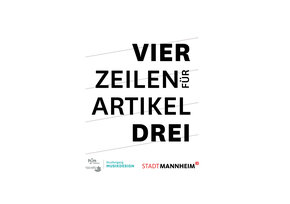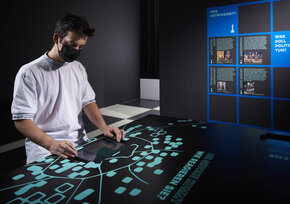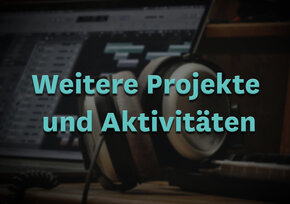
Music Design contents
Bachelor of Music Design
On the basis of music performance training, music designers shape the sounds of the future. Technically innovative, musically demanding, and in interdisciplinary teamwork. Music designers create sound worlds for films, games, rooms, and products; they develop new concert formats; and they stand together on stage with traditional musicians.
How do you awaken emotions with music? When do we feel that a sound is warm, when does it feel cold? Music Design is concerned with music and sound and their potential for impact in the context of digital media. There are hardly any boundaries: from experimental to pop music, from film music to jazz, from electronic to traditional orchestral music, from innovative sound design, new sounds, or creative work with language.
Is your curiosity piqued? Get to know our projects!
Projects and activities
Application process
- Information from the University concerning the application process: hfm-trossingen.de/bewerbung
- Relevant regulations in the enrollment bylaws (in German): Enrollment bylaws (from page 21)
The application process for the Music Design program begins annually each February 1st with the publication of the application tasks to be completed. These tasks represent a mandatory part of the application portfolio and will be expanded through a wide range of your own work.
Download Application Tasks 2023 (in German)
April 1st is the annual application deadline (postmark date applies). The application must have completed in the Hochschulportal and the application porfolio must be in the mail by the end of the day. The application time period is from March 1st to April 1st each year.
The following documents must additionally be attached (in addition to the regular required documents such as the application form, diplomas, etc.):
a) A chronological list of your previous musical development with information about self-taught knowledge and guided instruction (instrumental practice, composition, audio/technical work, producing, ensemble activities, etc.) and where appropriate, published papers, competition success, etc.
b) Development of two application tasks, which are made available to download two months before the close of the application period.
c) A diverse, stylistically broad as possible spectrum of your own work. It is possible to include composed or improvised pieces, sound designs, collages, songs, film or video game scoring, audio-visual works, radio dramas, sound installations, and other formats. Maximum number of works: 5.
d) For b) and c) the following applies:
-The choice of style and form is up to the applicant
-Accepted formats: mp3 (at least 160 kbps), WAV, AIFF, MP4, MOV.
-Score, if available
-A description of all submitted audio files on 1/2 DIN A4 page in 12-point type. The following applies: the year of origin (only for c). On what idea/concept is the composition established? Were the sounds used recorded by you, or did they come from a sound library? What was acoustically played/sung by you or were software instruments used (if yes, which ones)? What methods of digital sound creation were used and why? If other people participated in the audio file: list all those involved, as well as their respective part in the overall work.
e) Provide all documents and media mentioned in this list on a USB stick (maximum data size: 1 GB). Further necessary documents (diplomas, CV, etc) are to be attached to the application in paper form, in accordance with the requirements applicable to all degree forms.
After the application deadline, the examination committee will view the available application portfolios. They will decide which applicants have shown talent and aptitude for the program and will be invited to the second phase.
Colloquium (approximately 5 minutes)
Questions about your application, further questions about submitted audio files, discussion about a performed piece, etc. may form part of the colloquium.
Aural Theory and Knowledge of Music Theory (approximately 5 minutes)
Applicants have the possibility to choose either jazz/pop-oriented tasks or "classically"-oriented tasks. Examination tasks may include: Single-voice melodies either notated, sung back, or performed back on an instrument of choice. Listening to simple chords: number of notes (diads, triads, tetrads), intervals, difference between major and minor chords. Rhythms played by the committee either notated, clapped, or spoken back. A melody will be created independently to a given chord progression (either sung or performed on an instrument).
Important: The second phase must be passed in order to be admitted to the third phase.
The third phase of the entrance examination consists of two parts and takes place at the Trossingen University of Music.
Live Performance of a Piece You Composed (approximately 2-4 minutes)
(Music, sound piece, or sound performance)
Acceptable instruments: Laptop with live electronics, piano/keyboard, voice, any musical instrument, sounding objects; style is completely up to you. It is not enough to play a prepared sequence arrangement or simply switch on or modulate pre-produced material just by pressing a button. The creative performance must be recognizable, explainable, and able to be reproduced upon request.
Performance of a Sound Sample (approximately 2-4 minutes)
This part will be created and developed independently on a given topic (poem, picture, film, etc.) within a preparation time of 2.5 hours. Acceptable media: Musical instruments, laptop, body sounds, live performance, voice, sounding objects, remix, etc.
Important: Both parts of the examination must be passed. The total number of points are calculated equally from all four parts of the second and third phases.
The acceptance or rejection will be given a few weeks after the entrance examination by the examination office of the Trossingen University of Music. Fifteen students are accepted annually to the Music Design program.
Study Regulations for Music Design
At the center of the Music Design program stands the Music Design LAB with the following subjects: Composition, sound design, and soundalikes. Other important content: Music theory, instrumentation, audio technology, information technology, choir/ensemble, musicology, and music pedagogy. However, independent projects support the program: here, the focus is on the curiosity to combine musical aspects with different content.
BA-V-20-1B (in German)
Since 2020, there is also the possibility to choose an artistic-pedagogical profile. Instead of elective module points, students will take pedagogical course offerings, which will prepare you for new career fields. With this additional qualification, it will also be possible to study further pedagogical courses (e.g. Master). Music Design students must decide on this profile by the third semester. To help you decide, pedagogical basics and participation in an artistic-pedagogical project are anchored into the first and second semesters.
BA-V-20-1A (in German)
FAQ
When can I apply?
The Music Design programme begins only in the Winter Semester. The application deadline is April 15th before the desired start semester (as the Winter Semester begins around October 1st each year, this is a little less than 6 months beforehand).
What type of degree is it?
Music Design concludes with an accredited "Bachelor of Music" (B.Mus or BM), which is only given by artistic music conservatoires (Musikhochschulen, in German). A maximum of 15 students are accepted each year.
How long is the typical length of study?
8 semesters/4 years
How many places are there?
Up to 15 per year.
Where do I study Music Design?
At the Trossingen University of Music and at Furtwangen University. The majority of the classes take place in Trossingen.
Is there an age limit?
No.
Do I need to be able to read music?
What counts is musical talent - definitely in an unconventional way. Reading music is not mandatory for the aptitude examination.
Do I need an Abitur (A-Levels or equivalent) to be able to study Music Design?
Applicants without a general higher education entrance qualification can also be admitted to the program if they have particular artistic talent and sufficient general education, which is proven separately in a so-called aptitude test.
How much is the tuition?
EU citizens taking Music Design as their first degree do not have to pay any tuition fees. That said, administrative fees and the student union contribution will be charged each semester.
As a Music Design student, can I apply for Bafög?
(Bafög, or Bundesausbildungsförderungsgesetz - Federal Education Funding Act is a German state-funded programme to support students in need during their studies. It is not available to those living in Germany on a student visa)
Yes, the degree entitles you to funding through Bafög.

Quicklinks
Bachelor Musikdesign
Auf dem Fundament einer musikalisch künstlerischen Ausbildung gestalten Musikdesignerinnen und Musikdesigner die Klänge der Zukunft. Technisch innovativ, musikalisch anspruchsvoll und in interdisziplinärer Teamarbeit. Musikdesigner*innen schaffen Klangwelten für Filme und Games, Räume und Produkte, entwickeln neuartige Konzertformate und stehen gemeinsam mit traditionellen Musiker*innen auf der Bühne.
Wie weckt man Emotionen mit Musik? Wann empfinden wir einen Klang als warm, wann als kalt? Musikdesign beschäftigt sich mit Musik und Klang und deren Wirkungspotential im Kontext digitaler Medien. Dabei sind kaum Grenzen gesetzt: von experimentell bis Pop, von Filmmusik bis Jazz, von Elektro bis zu traditionell-orchestraler Musik, von innovativem Sounddesign, neuartigen Geräuschen oder kreativer Arbeit mit Sprache.
Neugierig geworden?
Projekte kennenlernen
Projekte und Aktivitäten
Folge uns auf unseren Social Media Kanälen
Musikdesign Bewerbungsablauf
- Informationen der Hochschule rund um das Bewerbungsverfahren: hfm-trossingen.de/bewerbung
- Maßgeblich sind die Bestimmungen in der Immatrikulationssatzung: Immatrikulationsatzung
Das Bewerbungsverfahren für den Studiengang Musikdesign beginnt jährlich jeweils am 01. Februar mit der Veröffentlichung der zu bearbeitenden Bewerbungsaufgaben. Diese Aufgaben stellen einen wesentlichen Pflichtteil der Bewerbungsmappe dar und werden ergänzt durch ein breites Spektrum an eigenen Arbeiten.
Am 01. April jeden Jahres ist Bewerbungsschluss (es gilt der Poststempel). Bis Ende dieses Tages muss die Bewerbung im Hochschulportal (Bewerbungsportal) vorgenommen worden sein und die Bewerbungsmappe zur Post gebracht sein. Das Hochschulportal öffnet am 01. März und schließt am 01. April jeden Jahres.
Folgende Unterlagen müssen der Bewerbung (neben allgemeinen Anforderungen wie Bewerbungsbogen, Zeugnisse, ...) zusätzlich beigefügt sein:
a) Eine chronologische Aufstellung des bisherigen musikalischen Werdegangs mit Informationen über autodidaktische und unter Anleitung erworbene Kenntnisse (Instrumentalpraxis, Komposition, Audiotechnik, Producing, Ensembleaktivitäten, etc.) sowie ggf. Veröffentlichungen, Erfolge bei Wettbewerben, etc.
b) Die Bearbeitungen zweier Bewerbungsaufgaben, die zwei Monate vor der Bewerbungsfrist im Internet per Download-Verfahren zugänglich gemacht werden.
c) Ein vielfältiges, möglichst stilistisch breitgefächertes Spektrum eigener Arbeiten. Möglich sind komponierte oder improvisierte Musikstücke, Sounddesigns, Collagen, Songs, Film- oder Gamevertonungen, Audiovisuelle Werke, Hörspiele, Interactive Audio, Klanginstallationen sowie weitere Formate. Maximale Anzahl: 5.
d) Für b) und c) gilt:
- Die Wahl von Stilistik und Form steht den Bewerbenden frei.
- Zugelassene Medienformate: MP3 (mindestens 160 kbps), WAV, AIFF, MP4, MOV.
- Partitur, falls vorhanden.
- Beschreibung aller eingereichten Hörproben auf je einer 1/2 DIN A4 Seite in 12 Punkt Schrift. Daraus geht hervor: Das jeweilige Entstehungsjahr (gilt nur für c). Auf welcher Idee / welchem Konzept gründet die Komposition? Wurden die verwendeten Klänge aufgenom- men oder stammen diese aus Libraries? Was wurde akustisch selbst eingespielt/eingesungen, wurden Softwareinstrumente verwendet (wenn ja, welche)? Welche Methoden der (digitalen) Klanggestaltung wurden eingesetzt und warum? Falls weitere Personen an den Hörproben beteiligt waren: Aufführung sämtlicher Beteiligter unter Angabe des jeweiligen Anteils am Gesamtwerk.
e) Bereitstellung aller in dieser Auflistung genannten Dokumente und Medien auf einem USB-Stick (maximale Datenmenge: 1 GB). Weitere notwendige Unterlagen (Zeugnisse, Lebenslauf, etc.) sind gemäß den für alle Studiengänge geltenden Anforderungen den Bewerbungsunterlagen in Papierform beizufügen.
WICHTIGER HINWEIS!
Sollten Sie im Hochschulportal dazu aufgefordert werden, einen Link für die "1. digitale Phase" einzutragen, lassen Sie (wenn möglich) dieses Feld frei oder posten Sie dort einen Platzhalter (z.B. hfm-trossingen.de). Die oben gelisteten Bestandteile der Bewerbungsmappe müssen nicht per Sharlink zu Dropbox, GoogleDrive, OneDrive, o.ä. bereitgestellt werden, sondern per USB-Stick – siehe e).
Nach Bewerbungsschluss sichtet die eingesetzte Prüfungskommission die vorliegenden Bewerbungsmappen. Sie trifft die Entscheidung, welche Bewerbenden eine Begabung und Eignung für den Studiengang erkennen lassen und zur zweiten Phase eingeladen werden.
Die zweite Phase der Musikdesign-Aufnahmeprüfung besteht aus vier Teilen und findet an der Musikhochschule Trossingen statt.
Live-Vorführung eines selbst komponierten Stückes (Dauer: 2-4 Minuten)
(Musik- oder Klangstück, Sound-Performance)
Zugelassene Instrumente: Laptop mit Live-Elektronik, Klavier/Keyboard, Stimme, Musikinstrumente aller Art, klingende Gegenstände; Stilistik frei wählbar. Es genügt nicht, ein vorbereitetes Sequenzarrangement abzuspielen oder bereits vorproduziertes Material durch Tastendruck lediglich einzuschalten oder zu modulieren. Die kreative Leistung muss erkennbar, erklärbar und auf Wunsch reproduzierbar sein.
Aufführung eines Klangbeispiels (Dauer: 2-4 Minuten)
..., das innerhalb einer Vorbereitungszeit von 2,5 Stunden selbstständig auf ein vorgegebenes Thema (Gedicht, Bild, Film usw.) erfunden und entwickelt wurde. Zugelassene Medien: Musikinstrument, Laptop, Körpersounds, Live-Performance, Stimme, klingende Gegenstände, Remix, etc.
Kolloquium(Dauer ca. 5 Minuten)
Bestandteil des Kolloquiums können Fragen zur Bewerbung sein, Rückfragen zu eingereichten Hörproben, Diskussion über ein vorgespieltes Musikstück, etc.
Gehörbildung und theoretische Kenntnisse (Dauer: ca. 5 Minuten)
Die Bewerbenden haben die Möglichkeit, stilistisch zwischen Jazz/Pop oder „klassisch“ orientierten Aufgabenstellungen zu wählen. Zu den Prüfungsaufgaben können gehören: Einstimmig vorgespielte Melodien werden entweder notiert, nachgesungen oder auf einem Instrument freier Wahl nachgespielt. Hören von einfachen Akkorden: Anzahl der Töne (Zwei-, Drei- und Vierklänge), Intervalle, Unterscheidung von Dur- und Molldreiklängen. Vorgespielte Rhythmen werden entweder notiert, geklatscht oder gesprochen. Auf eine vorgegebene Akkordfolge wird eigenständig eine Melodie erfunden werden (singen oder auf einem Instrument spielen).
Wichtig: Alle Prüfungsteile müssen bestanden sein, werden gleich gewichtet und ergeben im Durchschnitt die Zulassungspunktzahl. Sobald einer der Prüfungsteile nicht bestanden ist, gilt die gesamte Aufnahmeprüfung als nicht bestanden.
Die Zu- oder Absage wird wenige Tage nach der Aufnahmeprüfung vom Prüfungsamt der Staatlichen Hochschule für Musik Trossingen erteilt. Es werden jährlich bis zu 15 Studierende für den Studiengang Musikdesign aufgenommen.
Studienordnungen für Musikdesign
Das Musikdesign LAB mit den Fächern Komposition, Sound Design und Soundalikes steht im Zentrum des Musikdesign-Studiums. Wichtige Inhalte sind zudem: Musiktheorie, Instrumentation, Audiotechnik, Informatik, Chor/Ensemble, Musikwissenschaft, Musikpädagogik. Aber auch eigenständige Interessen und Projekte unterstützt das Studium: hierbei steht die Neugier, musikalische Aspekte mit verschiedenen Inhalten zu verknüpfen, im Fokus.
Seit dem Jahr 2020 gibt es zudem die Möglichkeit, ein künstlerisch-pädagogisches Profil zu wählen. Anstelle von Wahlmodulpunkten belegen die Studierenden pädagogische Angebote, die auf neue Berufsfelder vorbereiten. Mit dieser Zusatzqualifikation wird zudem das Studieren weiterführender pädagogischer Bildungsangebote (z.B. Master) möglich. Für das Profil entscheiden sich Musikdesignstudierende zum dritten Semester. Zur Entscheidungshilfe sind im ersten und zweiten Semester pädagogische Grundlagen sowie die Mitwirkung an einem künstlicher-pädagogischen Projekt verankert.
FAQ
Wann kann ich mich bewerben?
Studienbeginn für Musikdesign ist ausschließlich das Wintersemester. Bewerbungsschluss ist der 15. April eines Jahres für das darauffolgende Wintersemester.
Wie heißt der Studienabschluss?
Musikdesign schließt mit dem staatlichen „Bachelor of Music“ (B.Mus.) ab, der nur an künstlerischen Musikhochschulen verliehen wird. Es werden bis zu 15 Studierende pro Jahrgang aufgenommen.
Wie lange dauert die Regelstudienzeit?
8 Semester (4 Jahre)
Wie viele Studienplätze gibt es?
Bis zu 15 pro Jahrgang.
Wo studiere ich Musikdesign?
An der Staatlichen Hochschule für Musik Trossingen und an der Hochschule Furtwangen. Der Großteil des Unterrichts findet in Trossingen statt.
Gibt es eine Altersbeschränkung?
Nein.
Muss ich Noten lesen können?
Was zählt, ist die musikalisch Begabung - durchaus in unkonventioneller Ausprägung. Notenlesen wird für die Aufnahmeprüfung daher nicht zwingend vorausgesetzt.
Muss ich Abitur besitzen, um Musikdesign studieren zu können?
Bei besonderer künstlerischer Begabung und hinreichender Allgemeinbildung, die in einer sogenannten Begabtenprüfung separat nachgewiesen wird, können auch Bewerberinnen und Bewerber ohne allgemeine Hochschulreife zum Studium zugelassen werden.
Details zur Begabtenprüfung
Wie hoch ist die Studiengebühr?
EU-Bürger müssen für Musikdesign als Erststudium keine Studiengebühren zahlen. Erhoben werden allerdings ein Verwaltungskostenbeitrag sowie der Studierendenwerksbeitrag.
Nähere Infos zu den Studiengebühren
Kann ich als Musikdesign-Student:in Bafög beantragen?
Ja, das Studium berechtigt zur Förderung durch Bafög.


